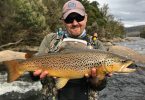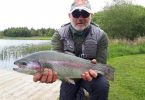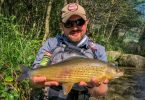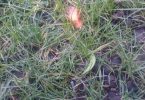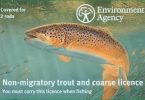How many times have you spent the day at a small stillwater fishery enjoying good sport during the morning, only to struggle during the second half of the day? More often than not this is due to trout shying away from an increasing bombardment of flies and more importantly fly lines, but this need not be so.
So what is this fantastic trick to catch more fish you say? The first thing to do is stand back from the fishing and analyse your approach. Not just the way you walk up to the lakeside but everything you do throughout the session. Your lakeside manner is a good place to start, as many anglers stand at the edge of the lake, consistently hauling out a long line across the pool. How many fish patrolling the margins are spooked like this? Obviously this is not an exact science, but from my own experience when the adrenalin drives you to “get fishing” I know that I have spooked fish before putting the breaks on and taking a step back.
Stepping back is quite literally what you should do. Take a couple of paces back from the waterside so that when retrieving line the rod tip just protrudes over the bankside. By doing this and lowering your profile, you spook less trout and allow casts to fish right into the bank, providing maximum opportunity for a take.
The next point is the real key to the day. Don’t flog the water! Resist the temptation to tie on that favourite team of flies or fly and start casting. Instead spend several minutes just scanning the water looking for fish and insect activity. If nothing is observed take a cautious walk around the lake(s) looking for signs of fish and fly life. When you find the trout the hardest job is done. You then can fish confidently in the knowledge that you are covering fish.
If nothing is moving anywhere then a safe assumption is to go with an intermediate line and tie on a nymph pattern appropriate for the water and time of year. The best advice I can give you here is to check the fishery logbook to see what flies consistently catch. Fish the water lightly, casting first across the marginal area to either side of you. Use the count down method to search from top to bottom and vary the retrieve. Having done this, search the water in front of you, casting in a fan formation and working from top to bottom. If you get a take remember the count at which it occurred and continue to work your fly at that depth. Ensuring your fly fishes at the depth trout are feeding is often more important than the pattern fished.

Should no takes occur move to the next available spot and start again. By working around the lake in this way, a lot of water is covered and you should find some fish. Now to totally surprise you, if you do catch a couple of fish and there is plenty of space to move to on the bank, now is the time to move. The fish are not feeding heavily and you standing their hammering them will only spook the remainder. You can always return later!
If your observations do find fish feeding at or close to the surface, use a floating line. Obviously I can’t say what fly to fish in this space, it could be any hatch at any stage of the process, with the trout gorging on any stage from ascending nymphs to full blown duns or even a spinner fall. The key thing to remember is again to take your time (not easy I know when it seems every trout is at the surface) and calculate what fly you need to attach to the end of your line.
Study where the trout are moving, is there a pattern to the rises? Do not cast out over fish in the margins just because the last fish to rise was twenty yards out. If fish are moving close in and seem to be cruising and rising along a certain route, then use this information to cast ahead of them and ambush them in turn, taking the closest to the bank first then working outward.
Follow this method and you will not go far wrong, develop it, as you like, it is not a strict science. Finally having caught the trout closest to you on that tiny black buzzer fished in the surface film after it rejected several patterns, don’t go straight for the next fish. Instead watch the water, have a cup of tea, anything, but do not start fishing immediately unless this is a really big hatch and the trout are rising with abandon.
The break between each fish caught will be the difference between catching 2 and catching a lot more. If only the odd fish is rising, then move having caught two and look for the next. Stay mobile fishing the water lightly, keep out of sight and your catch rate will go up!
Give it a try!
Steve Yeomans
Steve Yeomans provides fly fishing tuition and guided trips through his company Midlands Flyfishing.

